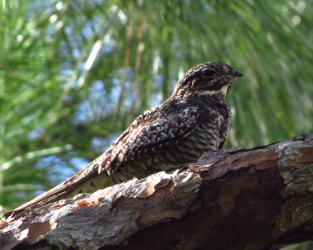By Dr. Marcel Gahbauer, Co-chair of COSEWIC’s Birds subcommittee

Common Nighthawk Photo: Susan Young
At its April meeting in Windsor, ON, the Committee on the Status of Endangered Wildlife in Canada (COSEWIC) reassessed the status of six bird species. The status of Coastal Vesper Sparrow, Streaked Horned Lark, and Chimney Swift remained unchanged. Common Nighthawk and Olive-sided Flycatcher are considered to be at less risk than they were previously. Red-headed Woodpecker has been elevated to a higher risk category.
Coastal Vesper Sparrow and Streaked Horned Lark are two subspecies native to the southern coast of British Columbia. Both were historically rare in Canada, and previously assessed as Endangered. There is no evidence that a breeding population of either subspecies remains in Canada, but if habitat remnants can be protected and restored, there is potential for recolonization from the U.S.
Chimney Swift was first assessed as Threatened in 2007 because of a substantial recent decline in abundance and distribution. In contrast to the previous two species, data suggest that the decline of Chimney Swift has accelerated over the past decade, although urban roost counts in recent years offer some signs of hope. COSEWIC therefore recommended maintaining the status of Threatened, with the hope that ongoing urban monitoring (through programs such as Bird Studies Canada’s SwiftWatch) will provide a clearer overview of trends the next time this species is reassessed.
Common Nighthawk and Olive-sided Flycatcher are two aerial insectivore species that are found in all provinces and territories. Both were assessed as Threatened in 2007 on the basis of steep declines over the previous three generations. Their declines have slowed down over the past decade. Given that they both still have large populations over extensive ranges, the status of both species has been revised to Special Concern.
Lastly, and unfortunately, the visually striking Red-headed Woodpecker is not faring well in Canada. First assessed as Special Concern in 1996 and then uplisted to Threatened in 2007, it was evaluated by COSEWIC at this meeting as Endangered. The Canadian population is now likely less than 6000 mature individuals, and continuing to decline steadily. Trends are also strongly negative in all adjacent states, reducing the probability of rescue.
A summary of the most recent status assessments of Canada’s wildlife can be viewed on the COSEWIC website.

